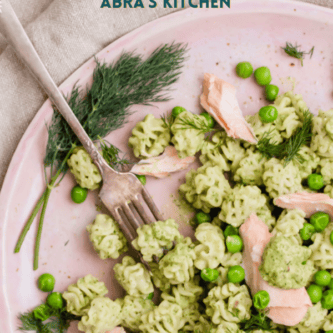A delicious seasonal recipe loaded with good-for-you ingredients. The pesto is made with zippy dill, avocado, and almonds for a real treat that pairs perfectly with tender poached salmon and pasta.
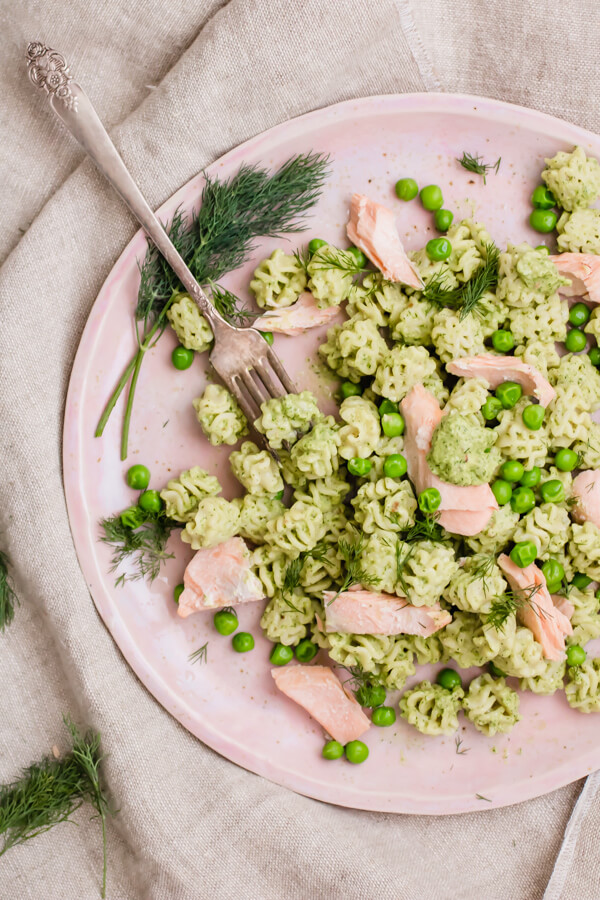
Spring and summer are pesto season in my kitchen! I skip jarred pestos in favor of making my own. It's a great way to use any herbs I have in the garden and it's fun to change up the flavor profile. Plus making my own means I am in full control over the ingredients and can adjust seasoning to my preference.
I adore pesto on so many things, and when combined with an al dente pasta and perfectly poached flaky salmon fillet, YUM! Now, this is a combination that I'm excited to share! This was a simple summer supper that I whipped up this week, not originally intended for the blog, but it was so stinking good that I had to make it a second time, photograph it, and share it!
I eat seafood several times a week, especially in the summer. Some of my other favorite seafood recipes are Icelandic Fish Soup (Fiskisupa), One Pot Mediterranean Cod, Lemon Roasted Sole and Asparagus, and this easy Korean Tuna Power Bowl.
You'll Love this Recipe
This is one of my new favorite salmon recipes. Easy enough for the home cook with restaurant-quality flavors that will impress.
- Poaching Perfection. Wild salmon has less fat than farmed salmon. Gentle poaching helps ensure tender salmon.
- A dairy-free pesto. This vibrant pesto is a fun diversion from the traditional fresh basil version. The addition of avocado creates a creamy sauce without the cheese, making this salmon pesto pasta recipe a great option for those who are dairy free or just looking to mix up their pesto
Let's Get Cooking!
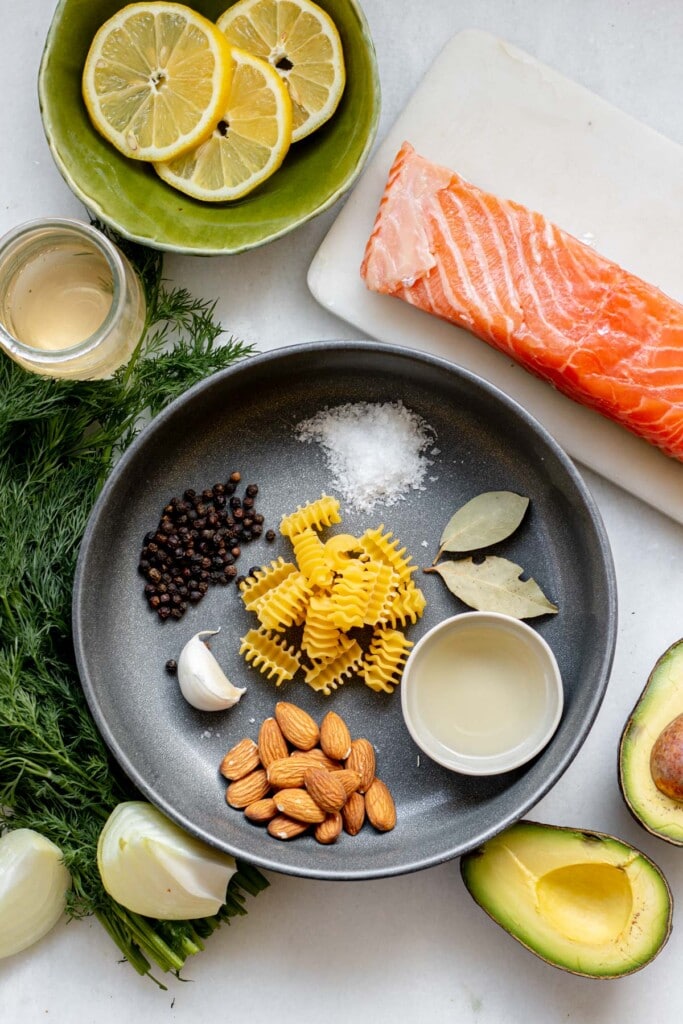
Ingredients You'll Need
While these aren't all of the ingredients needed, these are a few of the key ones to add to your shopping list. A full list with detailed measurements can be found below in the recipe card
- Wild Salmon – Wild is key when it comes to salmon as salmon is sadly one of the most contaminated foods in our food supply. Farmed salmon is high in many contaminants including polychlorinated biphenyls (PCBs) which has been strongly associated with cancer and other health problems (study found here). Most salmon filets sold at the grocery store seafood counter or fish markets have been previously frozen or flash frozen. This is perfectly fine. I often cook from frozen and just defrost first for best results.
- Fresh Dill – Fresh dill offers such an amazing flavor. Buy a huge bunch, make extra dill pesto and pour it on everything you eat all week long!
- Almonds – Heart-healthy raw almonds. You can substitute any nut you'd prefer, but I think almonds are fantastic in this dish.
- Avocados – Make certain that they're ripe and ready to go. You can tell an avocado is ripe by the feel. If it's got a little “give” when you squeeze, it's tender and ready. If it's hard as a rock, you'll need to let it ripen more before use.
- Green Peas – Frozen peas work perfectly here.
- Pasta – I love raddiatore-shaped pasta in this recipe, but as I am now gluten-free that is not easy to find. For a gluten-free version I used small penne.
Easy Step-by-Step Instructions
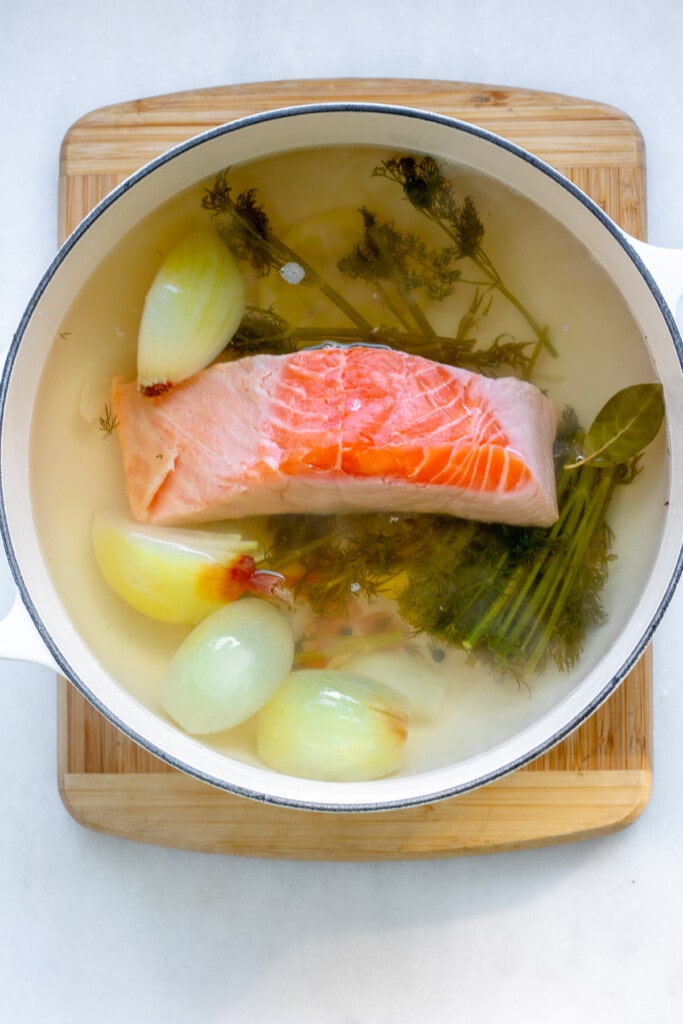
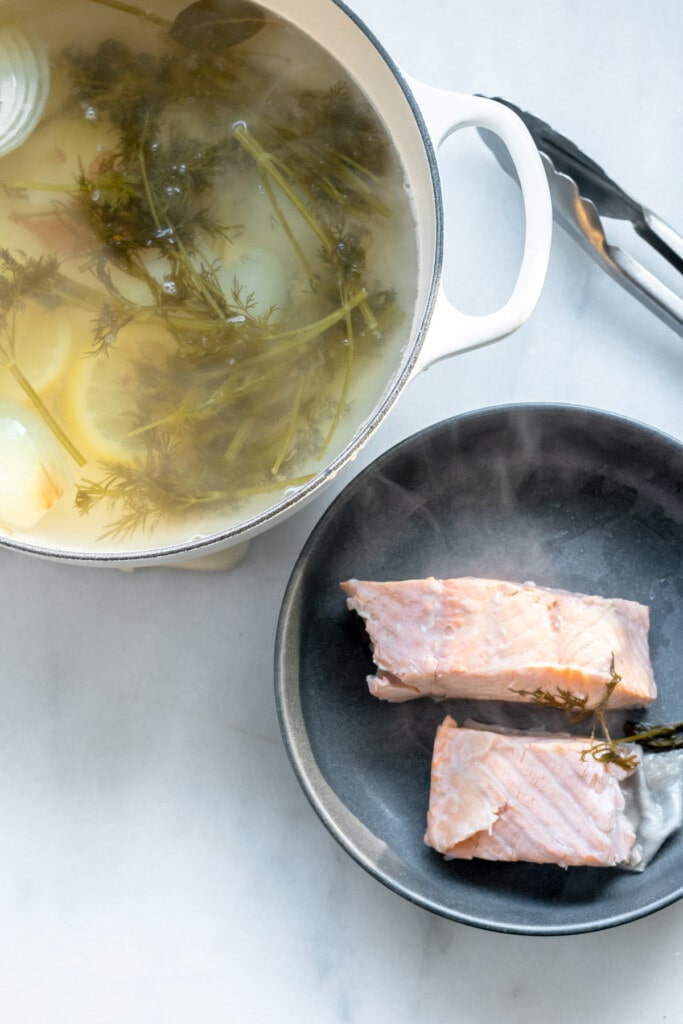
Poached Salmon
- Make your poaching liquid by combining water, wine, lemon, vinegar, onion, bay leaves, fresh dill, and peppercorns, and bringing to a boil. Reduce heat, cover, and simmer for 10 minutes.
- Add salmon and bring to a rolling simmer, partially cover, and cook for 4 minutes. Then, turn off the heat, cover completely, and allow salmon to rest for 2 minutes. A salmon filet that is 1-1 1/2″ will be cooked perfectly. Increase cook time for salmon, checking every 2 minutes.
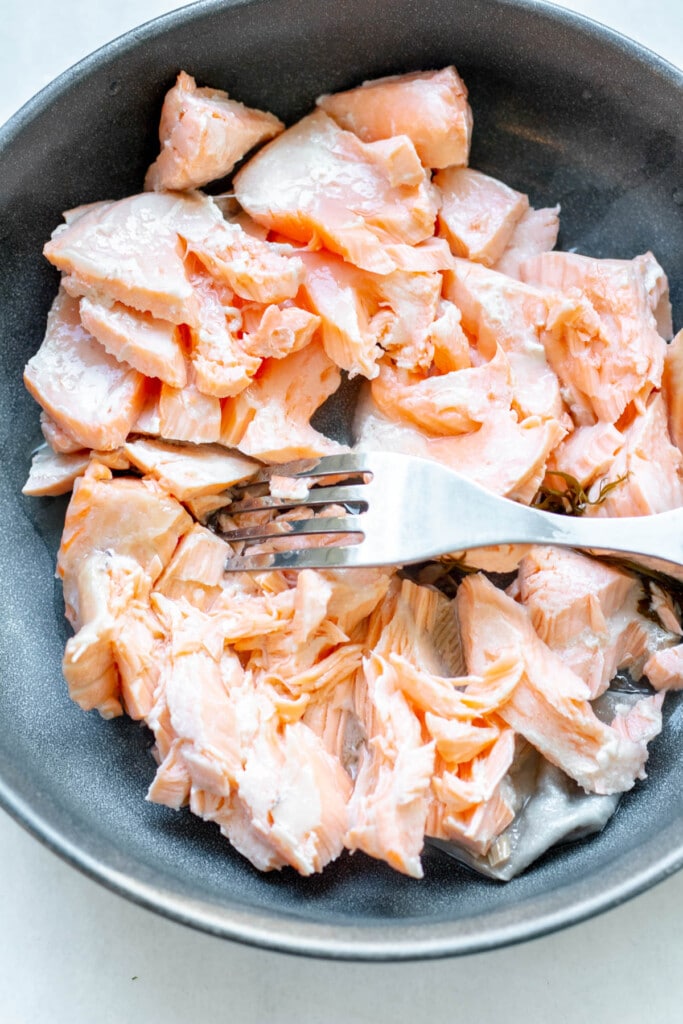
- Set salmon aside while you prepare other ingredients.
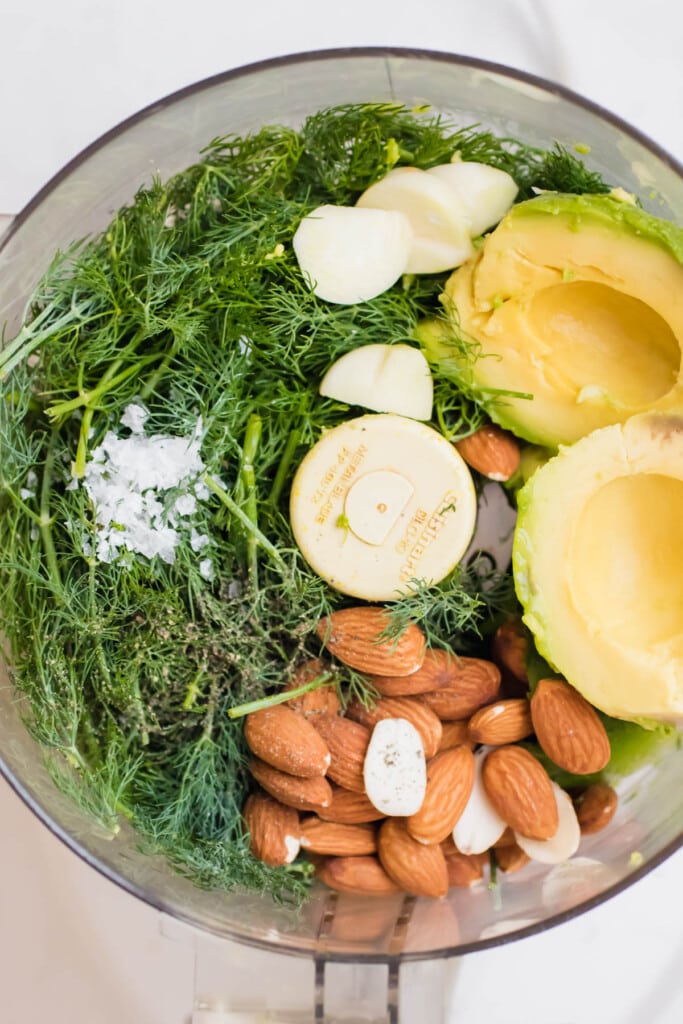
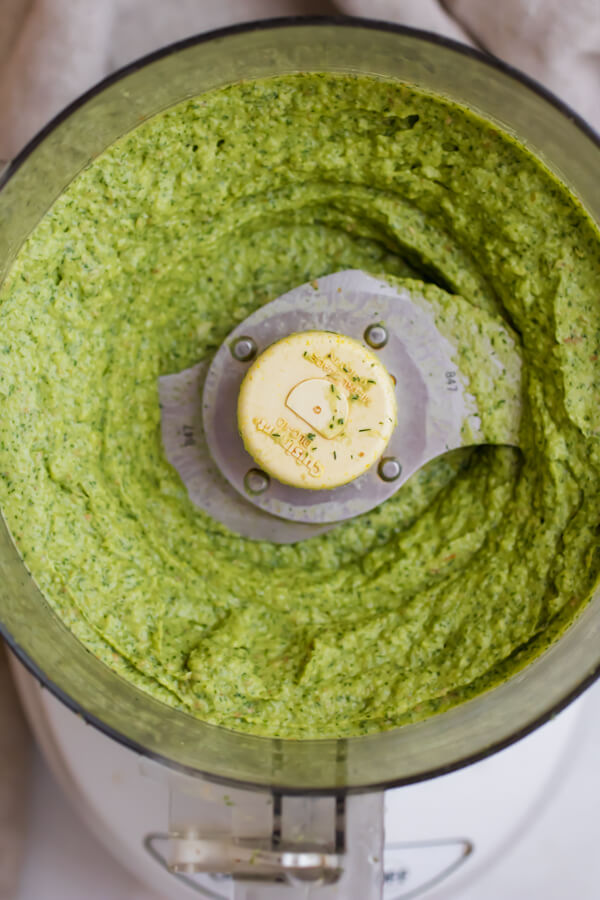
Dairy-Free Avocado Dill Pesto
Making your own pesto is so easy that I honestly beg you to try it just once, and you will never again use store-bought pesto.
- Traditional Pesto is a sauce originating from Italy that is typically created using pine nuts, basil, olive oil, parmesan cheese, garlic, and salt. If you want to try a traditional pesto recipe, here is my Perfect Every Time Basil Pesto recipe.
- For this recipe, I whipped up an avocado-based pesto using almonds and fresh dill. This pesto you will want to eat with a spoon, and I give you full permission to do so.
- To make dairy-free avocado dill pesto, you will simply combine avocado, lots of fresh dill, lemon juice, almonds, and garlic in the bowl of a food processor and process until smooth. You may need to add a bit more liquid to get it going (water is fine or more lemon juice) but the end result will be a thicker pesto. When preparing the pasta stir in some starchy pasta water to loosen the consistency and get ready to have your mind blown!
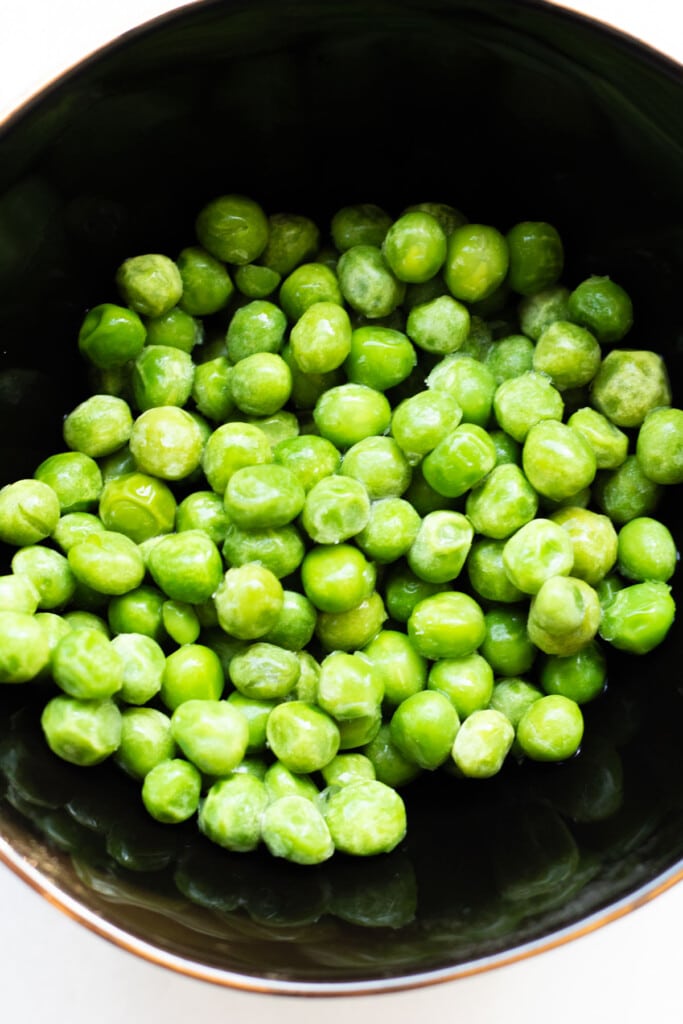
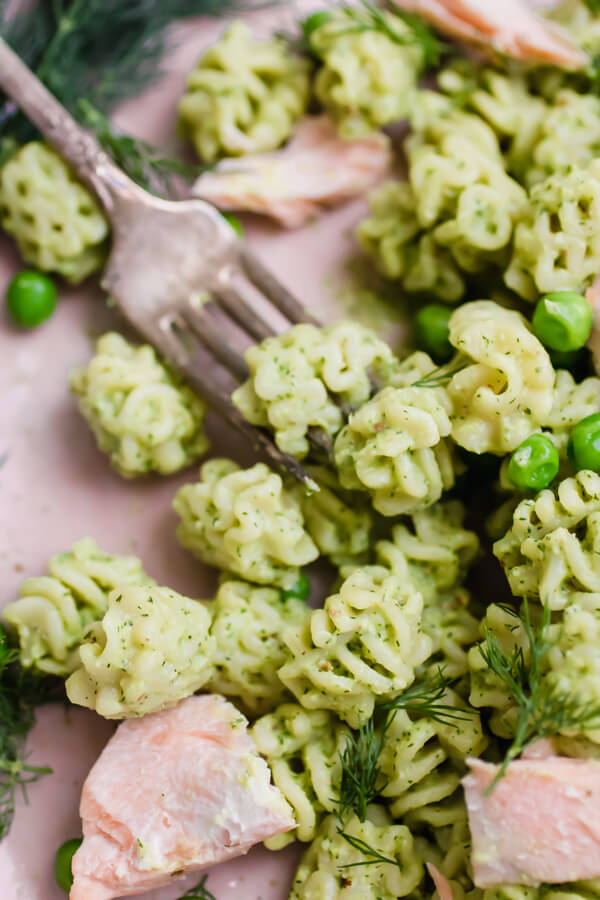
Salmon + Pesto + Pasta = 🤯
- Cook pasta according to package directions in a large pot of salted water. Be sure to boil in well salted water. In the final 2 minutes of cooking add peas to pasta water. Drain the pasta and peas reserving some of the starchy cooking liquid. Toss hot pasta and peas with 1-2 cups pesto (as much as you like) and flaked salmon.
- Top with additional fresh dill and a squeeze of fresh lemon. Enjoy immediately.
Here are a few more pesto twist recipes: almond basil pesto, carrot top pesto, and of course now this Avocado Dill-Almond Pesto!
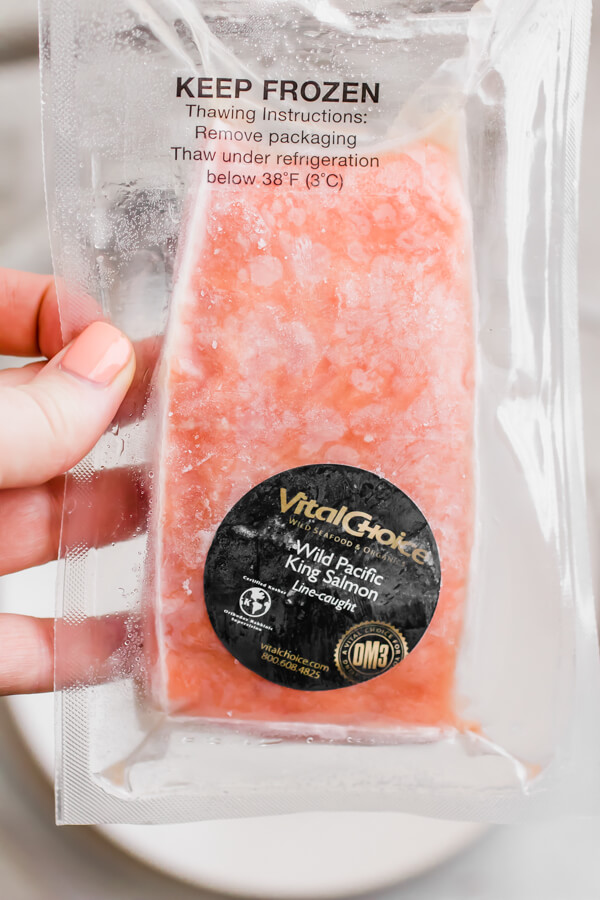
Wild vs. Farmed Salmon
Wild caught salmon is a non-negotiable in my house. The nutritional difference between wild salmon and farmed salmon is vast, beyond the issue with contaminants (which is my greatest concern) farmed salmon is also much higher in fat. Many environmental toxins are lipophilic or fat loving, meaning the higher the content of fat in the food the higher the level of contamination.
Wild salmon is caught in natural environments like oceans, streams, rivers, and lakes. In their natural habitat salmon eat other organisms like plankton, shrimp, squid, and eel.
Whereas farmed salmon are bred in controlled environments and fed processed high fat, high protein fish feed to produce larger fish.
The general recommendation is to eat wild salmon 3+ times per week, but farmed salmon no more than 1x per month. My recommendation is to eat farmed salmon never and wild salmon as often as you can.
Expert Tip
- Be sure to salt your pasta water generously. This is the only opportunity to season the actual pasta. Your pasta water should taste like the sea.
- Reserve a cup of pasta water. The starchy, salty reserved pasta water is an excellent emulsifier for your sauce. Once you add the pesto to the pasta begin to slowly drizzle in pasta water and stir to loosen the consistency while at the same time adding volume and body to the sauce. This is how your favorite Italian restaurant makes its sauces the perfect texture.
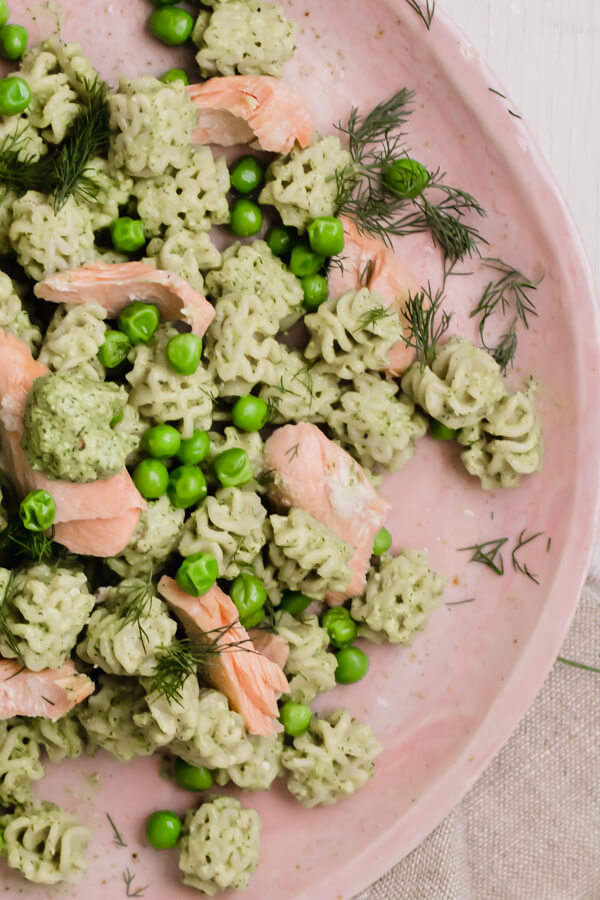
Make Ahead, Storage, Reheating, and Freezing Instructions
- MAKE AHEAD – The best thing about homemade pesto is the many ways you can use leftovers! Simply add your leftover pesto to an airtight container and keep it stored in the fridge in an airtight container for up to 5 days. Or you can pour leftover pesto into ice cube trays, freeze, and then store the pesto ice cubes in your freezer for up to 6 months. When you feel like pesto simply grab a pesto cube and melt in a pan, toss with pasta, grains, or veggies, and VOILA! Pesto! 🙂 You can also poach the salmon ahead of time and store in an airtight container in the fridge
- STORAGE – Store prepared dish in the fridge for up to 3 days in an airtight container. Poached salmon that has not been sauced can also last in the fridge for 3 days. This is the best way to save for a later date, adding the sauce to the salmon at the time of consumption.
- REHEATING – reheat leftovers on the stovetop over a gentle flame until warmed through. Avoid over-stirring as it will break up the salmon into pulverized pieces. You can also reheat in the microwave.
- FREEZING – This is not a great candidate for freezing.
I actually prefer to make my pesto thicker, I find the flavors are more concentrated. You can thin it out by adding more olive oil or a splash of water or vegetable stock, or when you are ready to toss with your pasta reserve some starchy pasta cooking liquid and toss the pasta, and pesto together with that salty starchy water for the perfect consistency.
The best thing about homemade pesto is the many many ways you can use leftovers! Simply add your leftover pesto to a sealable container and keep it stored in the fridge for up to 5 days. Or you can pour leftover pesto into ice cube trays, freeze, and then store the pesto ice cubes in your freezer for up to 6 months. When you feel like pesto simply grab a pesto cube and melt in a pan, toss with pasta, grains, or veggies, and VOILA! Pesto! 🙂
Because of its versatile flavor, you can add pesto to rice, potatoes, roasted vegetables, as a spread on sandwiches, dollop on top of hard-boiled eggs (OMG so good!), or even spread some on toasted bread for a quick afternoon snack.
It's completely up to you. I think a good quality dried pasta works best in this dish as it's firmer texture holds up better under the weight of the pesto sauce.
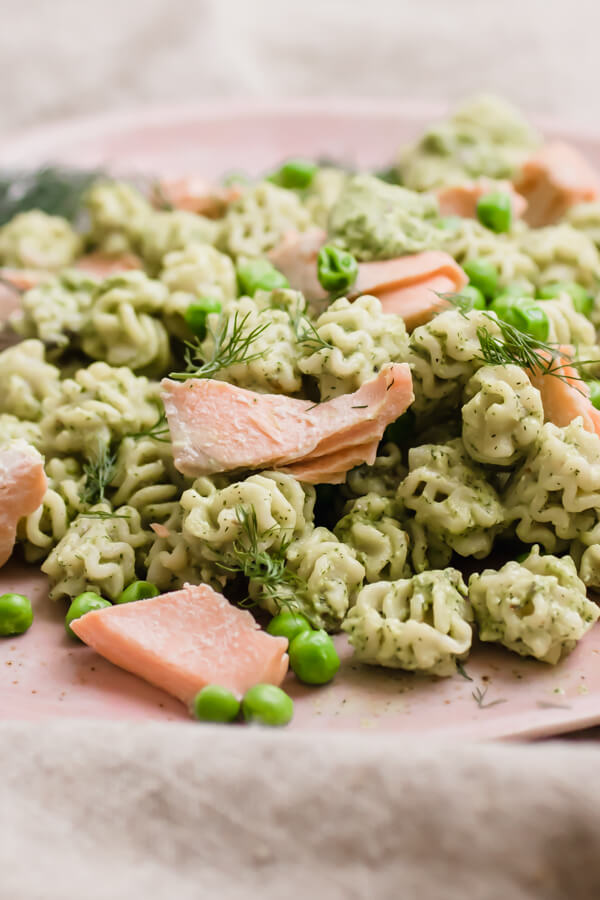
I hope you love this dairy-free poached salmon pesto pasta! If you make it be sure to tag me @abrapappa on Instagram so I can see your masterpiece!
If you’ve tried this recipe, don’t forget to rate it and leave a comment below. I love to hear from people who’ve made my recipes!
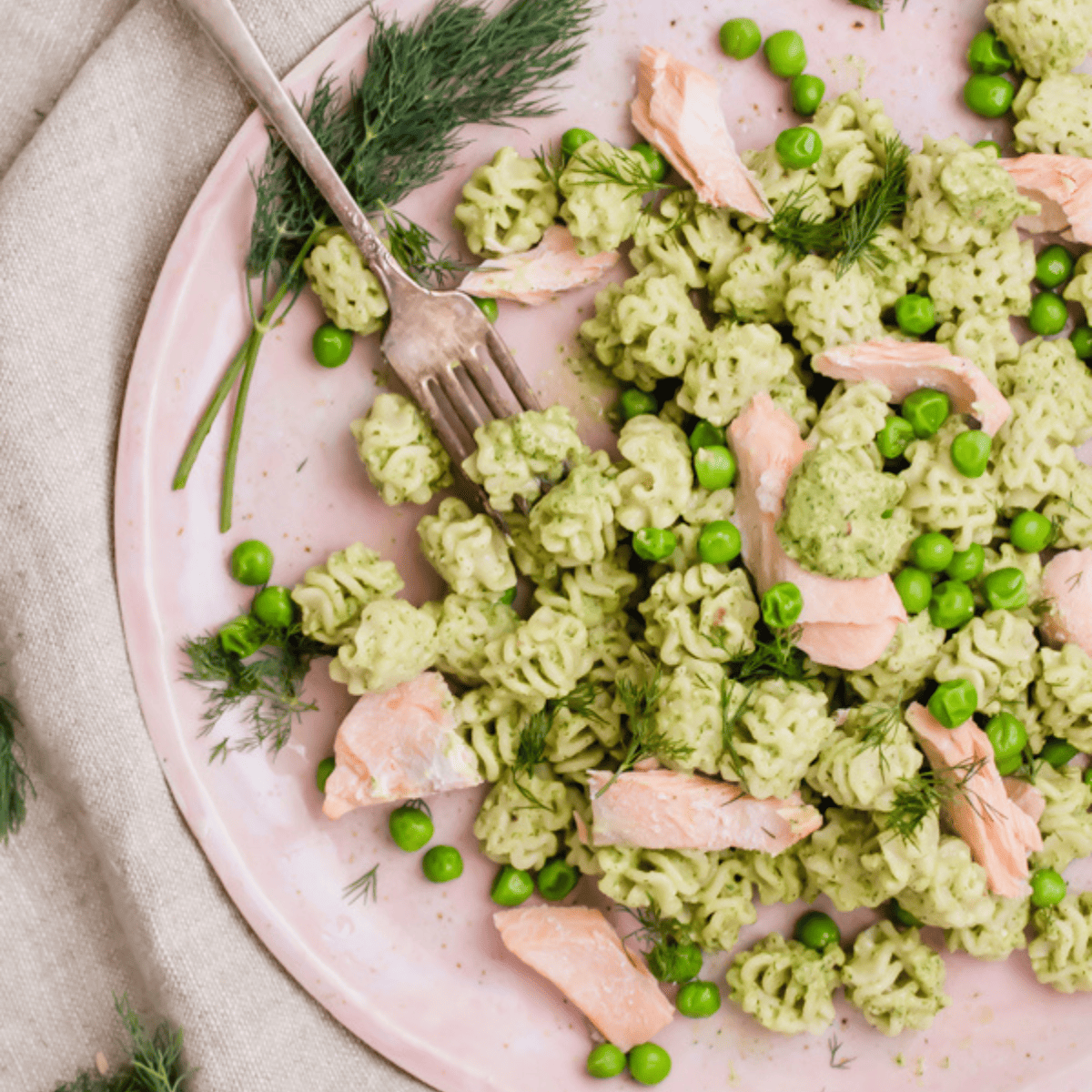
Poached Salmon Pesto Pasta
Ingredients
Poached Salmon
- 1 lb. wild salmon
- 3 cups water
- 1 cup white wine
- 3 slices fresh lemon
- 1/2 cup fresh dill
- 1 small onion quartered
- 2 bay leaves
- 1 tbsp rice wine vinegar
- 1 tsp salt
- 1 tsp black peppercorns
Vegan Avocado Almond Pesto
- 2 medium avocados
- 2 cups fresh dill
- 1/3 cup raw almonds
- 1 small garlic clove
- 2 tbsp lemon juice
- 1/2 tsp sea salt
- 1/4 tsp ground black pepper
Pasta
- 1 pound radiatore pasta or any pasta you like
- 1 cup green peas
Instructions
Poached Salmon
- In a large pan with high sides combine water, wine, lemon, vinegar, onion, bay leaves, fresh dill, peppercorns, and salt. Bring to a boil, reduce heat, cover and simmer for 10 minutes to allow flavors to concentrate. This is you poaching liquid.
- Remove cover, add salmon, increase heat to a rolling simmer, partially cover and cook for 4 minutes. After 4 minutes turn off heat, cover completely and allow salmon to rest for 2 minutes. A salmon filet that is 1-1 1/2" will be cooked perfectly. If your salmon is thicker increase cooking time by 2 minutes and then check.
- Set salmon aside while you prepare other ingredients.
Vegan Avocado Almond Pesto
- In the bowl of a food processor combine avocado, dill, almonds, garlic, lemon juice, salt, and pepper. Process until smooth. You may need to add a splash of water or a bit more lemon juice to get things going.
- Taste for seasoning, add more salt or lemon juice if needed.
Pasta
- Cook pasta according to package instructions. Be sure to boil in well salted water. In the final 2 minutes of cooking add peas to pasta water. Drain the pasta and peas reserving some of the starchy cooking liquid. Toss hot pasta and peas with 1-2 cups pesto (as much as you like) and flaked salmon.
- Top with additional fresh dill and a squeeze of fresh lemon. Enjoy immediately.
Notes
- You can use any type of pasta you like. Radiatore (like little radiators) is one of my favorites, but any small pasta (ideally with ridges) would work well.
- You can eliminate the peas if you don't like them.
- You will have extra pesto leftover, store it in the fridge for up to 5 days.
- The nutritional analysis includes the entire portion of pesto.
Nutrition
If you love this Avocado Dill Pesto Pasta with Poached Salmon recipe, you will also love these recipes!
Roasted Golden Beet Panzanella Salad with Burrata Cheese
Almond Pesto Potato Salad with Green Beans

